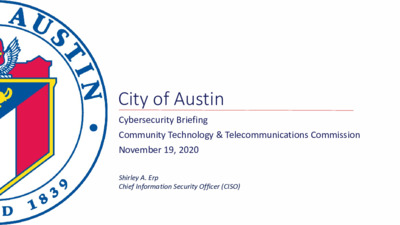Agenda Item 2b: CoA CISO Cybersecurity Briefing for CTTC — original pdf
Backup

City of Austin Cybersecurity Briefing Community Technology & Telecommunications Commission November 19, 2020 Shirley A. Erp Chief Information Security Officer (CISO) About Shirley Over 20 years Information Security Experience in Health, Education, Banking, Retail, Insurance, Energy, Government (Federal, State, and Local) Education: • Master of Science (MS) in Technology Management • Bachelor of Science (BS) in Computer Science Certifications: • Certified Information Systems Security Professional (CISSP) • Certified Information Systems Auditor (CISA) • Project Management Professional (PMP) • Certified Data Privacy Solutions Engineer (CDPSE) • IT Infrastructure Library (ITIL) Chief Information Security Officer Shirley Erp City of Austin Agenda • Information Security Office (ISO) Introduction • FY2021 High-Level Plan • “BlueLeaks“ Third-Party Data Exposure • Protecting Residents and the City of Austin 3 Information Security Office Introduction CoA Cybersecurity Program Alignment with: • Federal - National Institute of Standards and Technology (NIST) Cybersecurity Framework (CSF) • State - State of Texas Laws, Regulations, and Rules • Cybersecurity Best Practices Protection of: • Critical information systems and assets • Confidential information including personal private information Collaborative with: • City departments • Regional partners • State and local entities 5 CoA Information Security Program Security and Privacy: The How: Information security is a set of practices intended to keep data secure from unauthorized access or alterations. Here's a broad look at the policies, principles, and people used to protect data • Confidentiality - Protecting confidentiality is dependent on being able to define and enforce certain access levels for information Integrity - Integrity assures that the data or information system can be trusted • • Availability - Authentication mechanisms, access channels, and systems all have to work properly to protect information and ensure it is available when needed The What: Information privacy pertains to personally identifiable information. At the City, this includes the personal data collected, assembled, maintained, or prepared on behalf of the City of Austin. 6 § 2-11-16 - INFORMATION SECURITY OFFICE • Leads, directs, and manages the citywide information security program, including: City Code • Policy • Risk management • Security operations • Security architecture • Incident response • Governance • Privacy § 2-11-17 - DUTIES OF DEPARTMENT DIRECTORS - INFORMATION SECURITY • • Implement security program requirements Include resource expenditures for information security and privacy 7 Overview What We Want Risks We Face How We Mitigate This VISION: Austin is a beacon of sustainability, social equity, and economic opportunity… CHALLENGE: If we do not manage these risks, we have a problem s e m o c t u O c i g e t a r t S Economic Opportunity and Affordability Mobility Safety Third-Party Risk Regulatory & Compliance Risk Ad-Hoc Practices Complexity of Technology Culture and Lifelong Learning Government That Works for All Being Unaware of Incidents Being Unprepared to Respond Improve Incident Response Mature Processes Improve Proactive Risk Mgmt. Solution Protect our Data & Services 8 Health and Environment Loss of Data / Services Improve Monitoring Mature Governance How We Do It In order to implement the solutions, we have adopted the National Institute of Standards and Technology (NIST) Cybersecurity Framework (CSF) Improve Incident Response Improve Monitoring Improve Proactive Risk Mgmt. Solution Protect our Data & Services Mature Processes Mature Governance • Manage cybersecurity risk to systems, assets, data, and capabilities • Implement safeguards to ensure delivery of critical infrastructure services • Identify the occurrence of a cybersecurity event • Take action regarding a detected cybersecurity event • Maintain plans for resilience and restore capabilities or services impaired due to a cybersecurity event Identify Protect Detect Respond Recover 9 Connecting Strategy and NIST CSF Function Categories • Manage cybersecurity risk to systems, assets, data, and capabilities Identify • Implement safeguards to ensure delivery of critical infrastructure services • Identify the occurrence of a cybersecurity event • Take action regarding a detected cybersecurity event • Maintain plans for resilience and restore capabilities or services impaired due to a cybersecurity event Protect Detect Respond Asset Management • Business Environment • Governance • Risk Assessment • Risk Management Strategy • Supply Chain Risk Management Identity Management, Authentication, and Access Control • Awareness & Training • Data Security • Info. Protection Processes and Procedures • Protective Technology Anomalies and Events • Security Continuous Monitoring • Detection Processes Response Planning • Communications • Analysis • Mitigation • Improvements Recover Recovery Planning • Improvements • Communications 10 FY2021 High-Level Plan ISO General Strategy Develop policies & standards Deploy systems & technology Build programs & processes 12 CoA Cybersecurity Projects Continue to Mature: • Policy and standards • Multi-factor authentication (MFA) • Identity and Access Management (IAM) • Defense-in-depth technologies • Cybersecurity monitoring 13 “BlueLeaks” Third-Party Data Exposure Public Information About BlueLeaks • Third-party vendor was compromised impacting over 200 nationwide law enforcement agencies • June 19, 2020 –269 gigabytes of internal U.S. law enforcement data was exposed • Exposure included personal data of 700,000 police officers • Austin Regional intelligence Center (ARIC) is one of the 200 agencies • ARIC responsibility spans 10 counties and various agencies, including the City of Austin 15 ARIC Notification https://www.austintexas.gov/department/austin-regional-intelligence-center 16 ARIC Notification https://www.austintexas.gov/page/blueleaks-data-loss-notification 17 Protecting Residents and the City of Austin Technology & Cybersecurity Considerations • Attack Surfaces - are the different points where an unauthorized user can attack a system, such as: • Attack Vectors - are the methods cybercriminals use to gain unauthorized access to a system, such as: • Physical • Network • Software • People • Compromised credentials • Misconfiguration • Vulnerabilities • Missing or weak encryption 19 How CTTC Can Help • Include security and privacy requirements in recommendations: • Architecture • NIST Controls • Security awareness • Contract agreements • Physical protections • Budget for Security • Separation of resident services from City business infrastructure 20